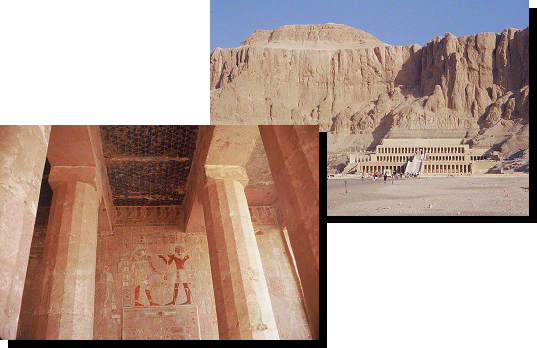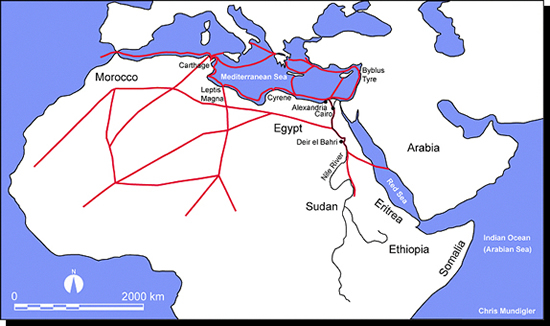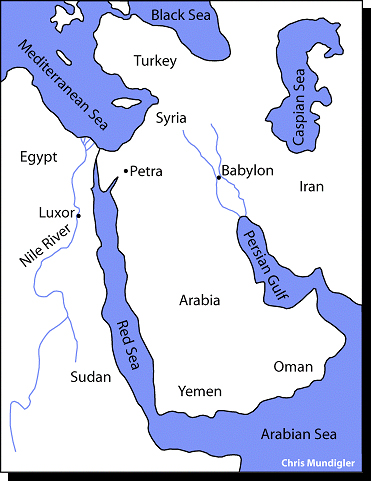The Ancient Spice Trade, Part II: Egypt and North Africa
By Chris Mundigler
Spices, oils and fragrances were traded in Egypt and North Africa much as they were further east in the region of Mesopotamia we investigated in the last issue of Labyrinth. Trade routes had been established very early on with the East for the import of commodities such as frankincense and myrrh from Arabia and more exotic goods such as cinnamon, cassia, scented oils and woods from India and beyond (figure 1). These aromatics and oils made their way west to Egypt for both the living and the deceased, and on as far as Morocco where spices such as saffron (figure 1) were used to please the discerning palates there.

Figure 1. Background left to right: frankincense, scented oil and myrrh;
foreground left to right: cinnamon, saffron and scented woods (photo: Chris Mundigler)
If we could wander the streets of the workers' villages near Giza in Egypt some 4600 years ago, we would find the intense aroma of spices from Asia as strong then as they are today. Spices were used in antiquity to give strength to the builders of the pyramids and the draw of the spice markets and perfume shops a mere stone's throw from those same pyramids today gives strength to modern-day explorers weary of the kitsch dealers and souvenir hawkers in the tourist traps. Stroll through one of these spice districts and be prepared for an assault on your senses as the smells of nutmeg and cloves from Indonesia mix with cinnamon from China and frankincense from Arabia - just as they did in the time of the pharaohs.
Hieroglyphics from Egyptian tombs and temples as far back as 5500 years tell of the burning of incense and sweet herbs for religious and mystical rituals, with cedars and aromatics being offered up to the gods and goddesses to ensure the fertility of the land. It was through this smoke - this perfume for the gods, or per fumum in Latin - that priests, then as now, tried to lift our religious spirits to a higher place.
Especially interesting from these temple walls is a record of an expedition sent out by Queen Hatshepsut around 1500 BC. Hieroglyphics on her mortuary temple at Deir el Bahri (in western Thebes, across the Nile from modern Luxor; figure 2) tell us volumes. Not only did the Queen favour cassia and cinnamon from China and Java, but she seemed particularly enamoured with frankincense - so much so that, according to inscriptions on her temple, she commissioned a shopping expedition to Punt. This fabled land lay somewhere to the south or east of Egypt, in the area of present-day Eritrea, Sudan, Somalia or perhaps even southern Arabia (figure 3). The Egyptians had known about Punt for some time before the 18th Dynasty of Queen Hatshepsut, but probably named it the "Divine Land" because they saw it as an endless source of frankincense, myrrh and cassia - all vital to their lives, rituals and afterlife. It was for this reason that Hatshepsut sent out her expedition in 1500 BC to bring back 31 frankincense trees, myrrh (and myrrh trees), cinnamon, numerous varieties of other incenses, cosmetics and perfumes.

Figure 2. Deir el Bahri, Queen Hatshepsut's mortuary temple and inscriptions (photos: Chris Mundigler).

Figure 3. Map of north African trade routes.
The inscriptions on her temple walls tell us that Hatshepsut's shopping spree imported such volume and variety of scents and spices for the first time that "Never was brought the like of this for any king who has been since the beginning1." With the number of trees she was importing, it may very well have been that Hatshepsut was trying to start her own production of frankincense resin. In all likelihood, though, she was unsuccessful as there are no records of commercial frankincense cultivation in Egypt at that, or any other, time.
While the Deir el Bahri inscriptions are a very important reference of the spice trade into Egypt - and accessible for any tourist to see - as we found out in the last issue of Labyrinth (number 82, October 2003), Herodotus told us about the fantastic sources of cinnamon and other spices in the ancient world as well (Histories, Book III). However, "huge birds of prey who made their nests out of massive cinnamon sticks" aside, what were the real sources of these Far Eastern spices coming into Egypt and North Africa?
In all likelihood, it was Indonesian merchants, using favourable winds to drive their ocean-going canoes, who travelled at great peril across the Indian Ocean to the northeast coast of Africa. In the area south of modern-day Somalia (figure 3), they off-loaded spices which could only be found in the Far East - cinnamon, cassia, cloves, nutmeg, mace, pepper and ginger. From there, the spices went north through Somalia to the Red Sea and then on to the Arabian merchants Herodotus mentioned. Once in Arabia, spices were fed into Syria to the north via Petra (in modern-day Jordan; figure 4) and west into Egypt itself.

Figure 4. Map of the ancient Near East.
Both the first century AD historian Josephus in his "Antiquities of the Jews" and the Old Testament Bible (I Kings 10:22 and II Chronicles 9:21) tell us that spice and precious metal trade expeditions came and went from the Red Sea to the East Indies, with the roundtrip taking up to three years. These journeys would have used the prevailing winds between the eastern Indian Ocean and Arabia which blew from the southwest between April and October, and from the northeast between October and April. Ports in Yemen and Oman, on the southern Arabian Peninsula (figure 4) were also used to import spices to the Red Sea where they made their way to Luxor on the Nile and then by ship northward to Cairo and Alexandria (figure 3).
The north-south trade route from the ports south of Somalia would have been met in the north by the east-west overland caravan routes from India bringing in riches and spices via centers such as Babylon (figure 4) on the way to Cairo, Alexandria and Carthage in North Africa (figure 3). It was on one such expedition that Joseph (of "Amazing Technicolour Dreamcoat" fame) was sold by his brothers to travelling spice merchants for 20 pieces of silver. These brothers "lifted up their eyes and looked, and behold, a company of Ishmaelites came from Gilead with their camels bearing spicery and balm, and myrrh, going to carry it to Egypt.2" These caravans, sometimes 4000 camels strong, brought incense, oils and spices from China, India and Indonesia into Egypt, and from there through North Africa and the rest of the known world.
Once in Egypt, these spices and incenses were used for a variety of purposes. There was, of course, the obvious use of spices in cooking and religious offerings - both of which are still done today - but the ancient Egyptians were also particularly concerned with their personal hygiene. As such, they used aromatics and scented oils in copious amounts - both as perfumes and as emollients to keep their skin from drying out under the harsh desert sun. This fascination with spices and perfumes continued on into the Egyptian afterlife as well. As part of their elaborate mummification process, the Egyptians used a variety of spices, including cassia, myrrh, anise, cumin and sweet marjoram, in their embalming - filling up the eviscerated bodies with aromatics and then sealing and soaking the corpses in sodium for 70 days before wrapping them. Spices were also placed in the tombs of the pharaohs to accompany their souls on the journeys to and from the afterlife. These spices and aromatic offerings were so well preserved that they were still easily detected when King Tutankhamen's tomb was opened after more than 3000 years!
These spices coming into Egypt also continued on through elaborate trade networks across North Africa by land and sea as far as Morocco (figure 3). Along the way, these trade missions mixed with the native Berber traditions in the west - as they had with the native Nabataeans in the east - and both these influences went on to benefit the later Greek, Roman and Arab invaders, as we'll see in the next few issues of Labyrinth.
_____________________________
1 translation: James Henry Breasted, "Ancient Records of Egypt: Historical documents, Volume II, the Eighteenth Dynasty" 1962, page 109.
2 Genesis 37:25-28